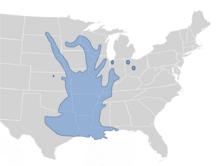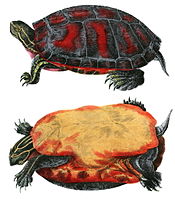False map turtle
| False map turtle | |
|---|---|

| |
| Scientific classification | |
| Kingdom: | |
| Phylum: | |
| Subphylum: | |
| Class: | |
| Order: | |
| Family: | |
| Subfamily: | |
| Genus: | |
| Species: | G. pseudogeographica
|
| Binomial name | |
| Graptemys pseudogeographica (Gray, 1831)
| |
| Subspecies | |
| |

| |
| Range map | |
| Synonyms | |
| |
The false map turtle (Graptemys pseudogeographica) is a species of turtle endemic to the United States. It is a common pet species. Two subspecies are recognized, including the nominotypical subspecies described here.
Description
Also known as a “sawback” turtle, the carapace features a vertebral row of low spines, and is serrated on the posterior rim. The carapace is olive to brown in color with light yellowish markings with dark borders. The plastron color varies from cream to yellow and is patterned with dark lines along the seams in juveniles. The body color of the false map turtle is grayish brown to blackish and is marked with light brown, yellow, or whitish stripes. The eye can be light yellow, white, or green and is crossed with a dark bar. Narrow hooked marks behind the eye fuse with dorsal lines on the head and neck. Also, small light-colored spots occur below the eye and on the chin.
Geographic range
The false map turtle lives in large streams of the Missouri and Mississippi River systems, ranging from Ohio, Indiana, Illinois, Wisconsin, Minnesota, through the Dakotas southward to southwestern Alabama, southern and western Mississippi, and Louisiana. The false map turtle also lives in several other river systems of Southwest Louisiana and East Texas.
Conservation status
In the Midwest, the false map turtle is a species of special interest in Ohio.
Behavior
Map turtles of all kinds are avid baskers, spending many hours during the day in the sun. When with other turtles, they also are very communal, sharing space and using each other for predator-watching, increasing the odds of surviving an attack.
Subspecies
- Nominotypical subspecies: G. p. pseudogeographica (Gray, 1831) – False map turtle
- G. p. kohnii (Baur, 1890) – Mississippi map turtle[1]
Ecology
The false map turtle is a strong swimmer and prefers rivers and large creeks with moderate currents, containing aquatic vegetation, as well as snags or floating logs. They are also comfortable in deep and swift water. The turtles are present in oxbow lakes and sloughs, but are absent from lakes, ponds, or small streams. Basking is important to these turtles, and they may even be found on steep, slippery snags.
Threats and management issues
A variety of threats face this species, including the destruction of nests of eggs by animals and insects, falling victim to gill nets, and being shot. False map turtles, much like red-eared sliders (Trachemys scripta elegans), have also been collected for the pet trade.
Gallery
-
Clutch preparation of a breeding false map turtle on a meadow
-
Same turtle during oviposition
References
- ^ a b c Graptemys pseudogeographica, Reptile Database
- ^ Fritz Uwe; Peter Havaš (2007). "Checklist of Chelonians of the World" (PDF). Vertebrate Zoology. 57 (2): 189. Archived from the original (PDF) on 17 December 2010. Retrieved 29 May 2012.
{{cite journal}}: Unknown parameter|deadurl=ignored (|url-status=suggested) (help)
Further reading
- Conant, R. (1975). A Field Guide to Reptiles and Amphibians of Eastern and Central North America, Second Edition. Houghton Mifflin. Boston. xviii + 429 pp. + 48 plates. ISBN 0-395-19979-4 (hardcover), ISBN 0-395-19977-8 (paperback). (Graptemys pseudogeographica, pp. 57–58 + Plate 8 + Map 14.)
- Ernst, C.H., J.E. Lovich and R.W. Barbour. (1994). Turtles of the United States and Canada. Smithsonian Institution Press. Washington, District of Columbia.
- Gray, J.E. (1831). Synopsis Reptilium; or Short Descriptions of the Species of Reptiles. Part I.—Cataphracta. Tortoises, Crocodiles, and Enaliosaurians. Treuttel, Wurz, and Co. London. viii + 85 pp. + 11 plates. (Emys pseudogeographica, p. 31.)
- Smith, H.M., and E.D. Brodie, Jr. (1982). Reptiles of North America: A Guide to Field Identification. Golden Press. New York. 240 pp. ISBN 0-307-13666-3 (paperback). (Graptemys pseudogeographica, pp. 50–51.)
External links
- Graptemys pseudogeographica, Illinois Natural History Survey
- False Map Turtle, Reptiles and Amphibians of Iowa
- Graptemys pseudogeographica, The Reptile Database




